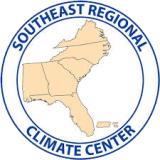Southeast Climate Monthly Webinar: April 23, 2024
The Southeast U.S. continues to be warmer than normal across much of the region. Drought is largely absent, and many rivers and creeks experienced flooding over the last month.
Warm and wet conditions are expected to continue through the spring and early summer. Drought is not expected to re-emerge widely across the region, although water demand is increasing as we transition into the spring. There is a slightly above-normal risk for river flooding.
Check out the recording below to hear more on Southeast climate conditions and a special presentation, "Loading the Dice: How Risk and Vulnerability Are Changing the Southeast Tornado Disaster Landscape” from Dr. Walker Ashley of Northern Illinois University. For more information, please contact Meredith Muth (meredith.f.muth@noaa.gov).
About This Webinar
The Southeast Climate monthly webinar series is hosted by the Southeast Regional Climate Center, the National Integrated Drought Information System (NIDIS), and the NOAA National Weather Service. These webinars provide the region with timely information on current and developing climate conditions such as drought, floods, and tropical storms, as well as climatic events like El Niño and La Niña. Speakers may also discuss the impacts of these conditions on topics such as agriculture production, water resources, wildfires, and ecosystems






